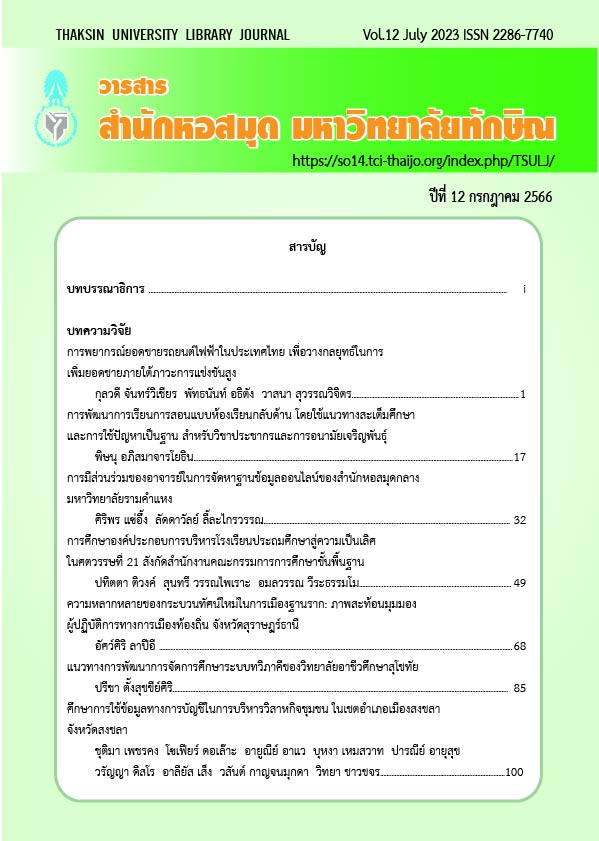Forecasting electric vehicle sales in Thailand: Setting marketing strategies for increased sales amidst high competition
Keywords:
Forecast Model, Time Series Analysis, Time Series Fragmentation, Forecast AccuracyAbstract
This article presents how to create an electric vehicle sales model in Thailand. In order to lay down strategies to increase sales under highly competitive conditions it is information that helps to reflect the important driving force both in economic and social. In the midst of technological changes and world-changing innovations country reform plan one such industry is the electric vehicle industry. The objective is to find the most suitable forecasting model for forecasting electric vehicle sales in Thailand. By collecting data from 2017-2021. By analyzing time series data (Time-Series Models method) using Decomposition (Moving Average method), Single Exponential Smoothing (Double Exponential Smoothing method) and Winters’ Exponential Smoothing Decomposition method, through the use of Minitab program to help analyze the appropriate forecast. It is evaluated by the result of the error of mean percent complete error (MAPE), mean of percent error (MAD), mean error squared average deviation (MSD). The appropriate forecasting method for the electric vehicle sales model in Thailand is the Moving Average, which provides the lowest margin of error. and using the aforementioned forecasting method, forecasting as a case study for the next 5 years to be used for further planning and strategic decision-making.
References
กรมการขนส่งทางบก, กลุ่มสถิติการขนส่ง. (2565). ข้อมูลการสถิติจำนวนรถยนต์จดทะเบียนใหม่ปริมาณยอดขายรถยนต์ไฟฟ้าในประเทศไทย จำแนกตามชนิดเชื้อเพลิง (ไฟฟ้า). สืบค้น 20 กันยายน 2565, จาก https://web.dlt.go.th/statistics/
การวิจัยกรุงศรีแนวโน้มธุรกิจ/อุตสาหกรรม ปี 2566-2568: อุตสาหกรรมรถยนต์. สืบค้น 23 กรกฎาคม 2566, จาก https://www.krungsri.com/th/research/industry/industry-outlook/hi-tech-industries/auto-parts/io/auto-parts-2023-2025
สมาคมรถยนต์ไฟฟ้าไทย. (2565). รายงานประจำปี 2565. สืบค้น 23 กรกฎาคม 2566, จาก http://www.evat.or.th/16803970/evat-directory
สํานักงานส่งเสริมวิสาหกิจขนาดกลางและขนาดย่อม. (2562). ยุทธศาสตร์และแผนปฏิบัติการส่งเสริมวิสาหกิจขนาดกลางและขนาดย่อม อุตสาหกรรม ยานยนต์ไฟฟ้า. สืบค้นจาก https://www.sme.go.th/upload/mod_download/download-20191022083111.pdf
Barbosar, N. (2015). Demand forecasting for production planning in a food company. ARPN Journal of Engineering and Applied Sxiences, 10(16), 7137-7141.
Cranage, D. A., & Andrew, W. P. (1992). A comparison of time series and econometric models for forecasting restaurant sales. International Journal of Hospitality Management, 11, 129-142.
Hansun, S. (2016). A new approach of brown’s double exponential smoothing method in time series analysis. Balkan Journal of Electrical & Computer Engineering, 4(2), 75-78.
Li, X. (2013). Comparison and analysis between holt exponential smoothing and brown exponential smoothing used for freight turnover forecasts, Third International Conference on Intelligent System Design and Engineering Applications (pp. 453-456). Hong Kong: Institute of Electrical and Electronics Engineers.
Nazim, A. & Afthanorhan, A. (2014). A comparison between Single Exponential Smoothing (SES), Double Exponential Smoothing (DES), holt’s (brown) and Adaptive Response Rate Exponential Smoothing (ARRES) techniques in forecasting Malaysia population. Global Journal of Mathematical Analysis, 2(4), 276-280.
Wongrawang, N. (2013). Opimal fabric inventory management for textile industry (Master’s Thesis). Nakhonpathom: Silpakorn University.


